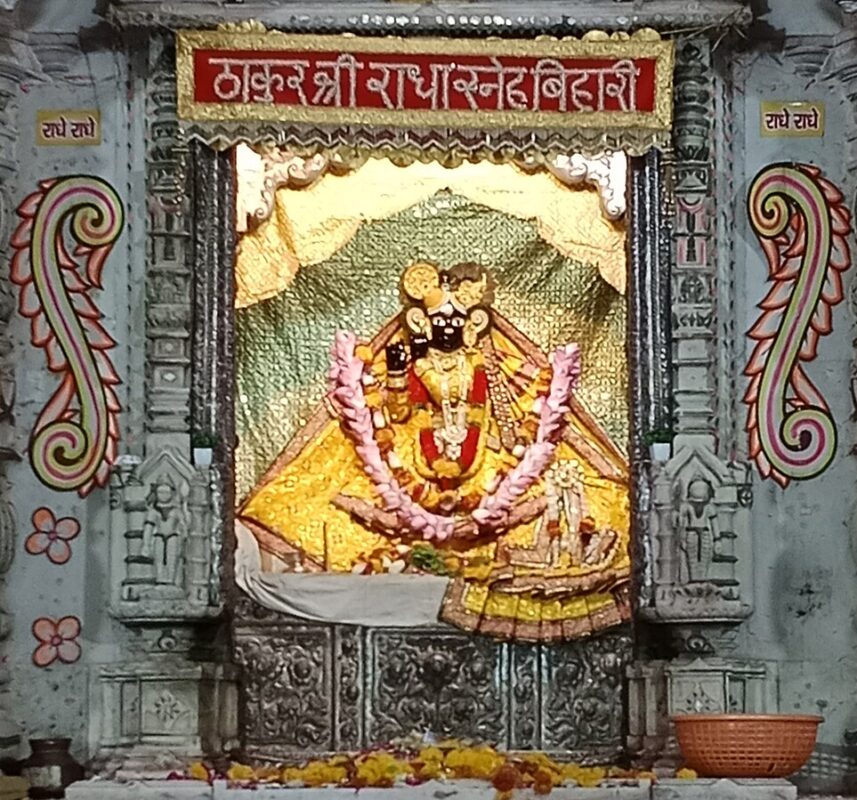Banke Bihari Temple
The Banke Bihari Temple in Vrindavan is a revered shrine where Lord Krishna is worshipped in his most enchanting and playful form. With its rich history, unique traditions, and vibrant celebrations, the temple offers a deeply spiritual experience for devotees from around the world.

Banke Bihari Temple, Vrindavan: Where Krishna’s Divine Charm Awaits
| Deity: | Lord Krishna |
| Location: | Mathura, Uttar Pradesh |
| Best time to visit | October-March |
| Open Hours | 7:45 AM–12:00 PM & 5:30 PM–9:30 PM |
| Popular festival | Janmashtami |
FAQ
Where is Banke Bihari Temple located?
Mathura, Uttar Pradesh
What is the origin or historical significance of the Banke Bihari Temple?
The Banke Bihari Temple is a revered shrine in Vrindavan, dedicated to Lord Krishna in his enchanting and playful form. The idol of Banke Bihari Ji was discovered in the 16th century by Swami Haridas, a great devotee of Lord Krishna and the guru of famous musician Tansen. The temple, as it stands today, was constructed in 1864 by devotees of Swami Haridas to house the sacred idol.
Who built or upgraded the Banke Bihari Temple?
Swami Haridas discovered the idol of Banke Bihari at Nidhivan, a sacred grove in Vrindavan. The temple was later constructed by his devotees in 1864, and over time, it has undergone various renovations and expansions to accommodate the growing number of visitors.
What are the cultural or mythological references associated with the temple?
As per the legend, Swami Haridas, through his devotional singing, summoned Lord Krishna and Radha, and the divine couple united to form the single idol of Banke Bihari. The term “Banke” signifies Krishna’s posture, bent at three points, while “Bihari” represents the supreme enjoyer. The temple’s deity symbolizes the joyous and playful nature of Lord Krishna, a theme central to the cultural significance of Vrindavan.
What are the unique points about the Banke Bihari Temple?
The Banke Bihari Temple is distinct for its traditions, including the belief that the deity’s gaze is so intense it overwhelms devotees. As a result, the idol is periodically concealed behind a curtain during darshan. Furthermore, the temple’s daily rituals are overseen by the Goswami family, descendants of Swami Haridas.
Why is the Banke Bihari Temple famous?
The Banke Bihari Temple is one of the most significant pilgrimage sites in Vrindavan, drawing devotees from all over the world. It is especially famous for its joyous celebrations during festivals like Holi and Janmashtami. Devotees believe that darshan of Banke Bihari brings immense spiritual joy and blessings.
What is unique about the temple’s architecture?
The temple is built in the Rajasthani architectural style, with intricate stone carvings and beautifully ornate wooden doors. The spacious courtyard can hold a large number of devotees, and the walls are adorned with paintings depicting scenes from the life of Lord Krishna. One of the temple’s key features is the idol of Banke Bihari, which is richly adorned with garments and jewelry.
When is the best time to visit the Banke Bihari Temple?
The best time to visit the Banke Bihari Temple is during the winter months from October to March, when the weather is pleasant. Major festivals such as Holi, Janmashtami, and Radhashtami bring a special vibrancy to the temple, making these times ideal for experiencing the joyous atmosphere.
How can one reach the Banke Bihari Temple?
The nearest airport is Indira Gandhi International Airport in New Delhi, approximately 150 km away. From there, you can take a taxi or bus to Vrindavan. Mathura Junction, located about 12 km from Vrindavan, is the nearest railway station, with regular train connections to major cities in India. Vrindavan is also well-connected by road, with buses and taxis available from nearby cities like Mathura, Agra, and Delhi.
In conclusion, the Banke Bihari Temple in Vrindavan offers a deeply spiritual and enchanting experience for devotees of Lord Krishna. Steeped in rich history, divine mythology, and unique traditions, the temple stands as a testament to the joyous and playful nature of the deity. Whether visiting for darshan or during one of the vibrant festivals, the temple promises a profound connection to the divine and an unforgettable journey of faith.







